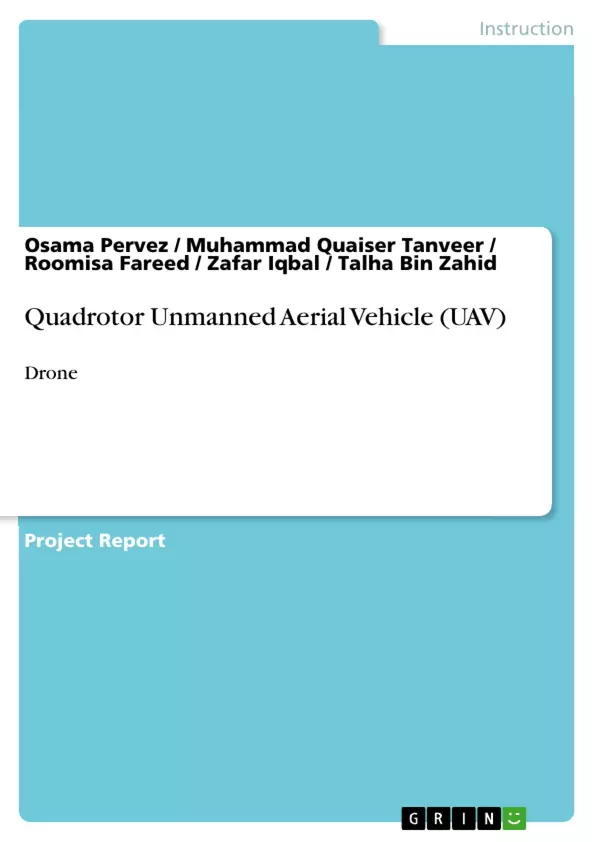Quad rotor helicopters have become increasingly important in recent years as platforms for both research and commercial unmanned aerial vehicle applications. This progress report explains work on several important aerodynamic effects. These vehicles have 4 identical rotors in 2 pairs spinning in opposite directions, and possess many advantages over standard helicopters in terms of safety and efficiency at small sizes.
Table of Contents
- Chapter One
- 1.1 History
- 1.2 Introduction
- 1.3 Design Proposal
- 1.4 Motivation
- 1.5 UAV Types
- 1.6 Scope
- 1.7 Description of project
- 1.8 Significance of project
- Chapter Two
- 2.1 Background
- 2.2 Overview
- 2.3 Flight Control
- 2.4 Quad rotor Services
- Chapter Three
- 3.1 Quad rotor Model
- 3.2 Basic concepts
- 3.3 Quadrotor Structure
- 3.4 System Integration
- 3.5 Flight Dynamics
- 3.6 Assumption
- Chapter Four
- 4.1 Hardware Components
- 4.2 Frame
- 4.3 Design of Frame
- 4.4 Brushless Motors
- 4.5 Electronic Speed Controllers
- 4.6 Power Supply System
- 4.7 LiPo Battery
- 4.8 LM7805
- 4.9 LD1117V33
- 4.10 LM317
- 4.11 Flight Stability Sensors
- 4.12 ATmega
- 4.13 Microcontroller Information
- 4.14 Camera
- 4.15 Wireless Communication
- Chapter Five
- 5.1 ORCAD
- 5.2 Keil uVision
- Chapter Six
- 6.1 APPLICATION
Objectives and Key Themes
This project aims to develop a quad rotor Unmanned Aerial Vehicle (UAV) for various applications. The project focuses on designing and implementing a robust and reliable quad rotor system capable of autonomous flight, data collection, and various other tasks.
- Quad rotor UAV Design and Development
- Flight Control Systems and Algorithms
- Hardware and Software Integration
- Autonomous Flight Capabilities
- Applications and Potential Uses of Quad rotor UAVs
Chapter Summaries
Chapter One provides an overview of the project, including its history, motivation, design proposal, and scope. It delves into different types of UAVs and highlights the significance of this project.
Chapter Two focuses on the background of quad rotor technology, exploring its flight control mechanisms and various services it can provide. It provides a comprehensive understanding of the technology behind quad rotor UAVs.
Chapter Three delves into the modeling and structural aspects of a quad rotor, explaining its basic concepts, structure, and system integration. It also touches upon the dynamics of flight and assumptions made during development.
Chapter Four examines the hardware components used in the quad rotor system. It elaborates on the design of the frame, motors, electronic speed controllers, power supply system, sensors, and other vital elements.
Chapter Five discusses the software aspects of the project, highlighting the use of software tools such as ORCAD and Keil uVision in designing and implementing the system.
Chapter Six explores various applications and potential uses of the developed quad rotor UAV, showcasing its capabilities and relevance in different domains.
Keywords
The project centers around the development and application of quad rotor UAVs. Key topics include UAV design, flight control systems, autonomous flight, hardware and software integration, and real-world applications.
- Quote paper
- Osama Pervez (Author), Muhammad Quaiser Tanveer (Author), Roomisa Fareed (Author), Zafar Iqbal (Author), Talha Bin Zahid (Author), 2008, Quadrotor Unmanned Aerial Vehicle (UAV), Munich, GRIN Verlag, https://www.hausarbeiten.de/document/273679


